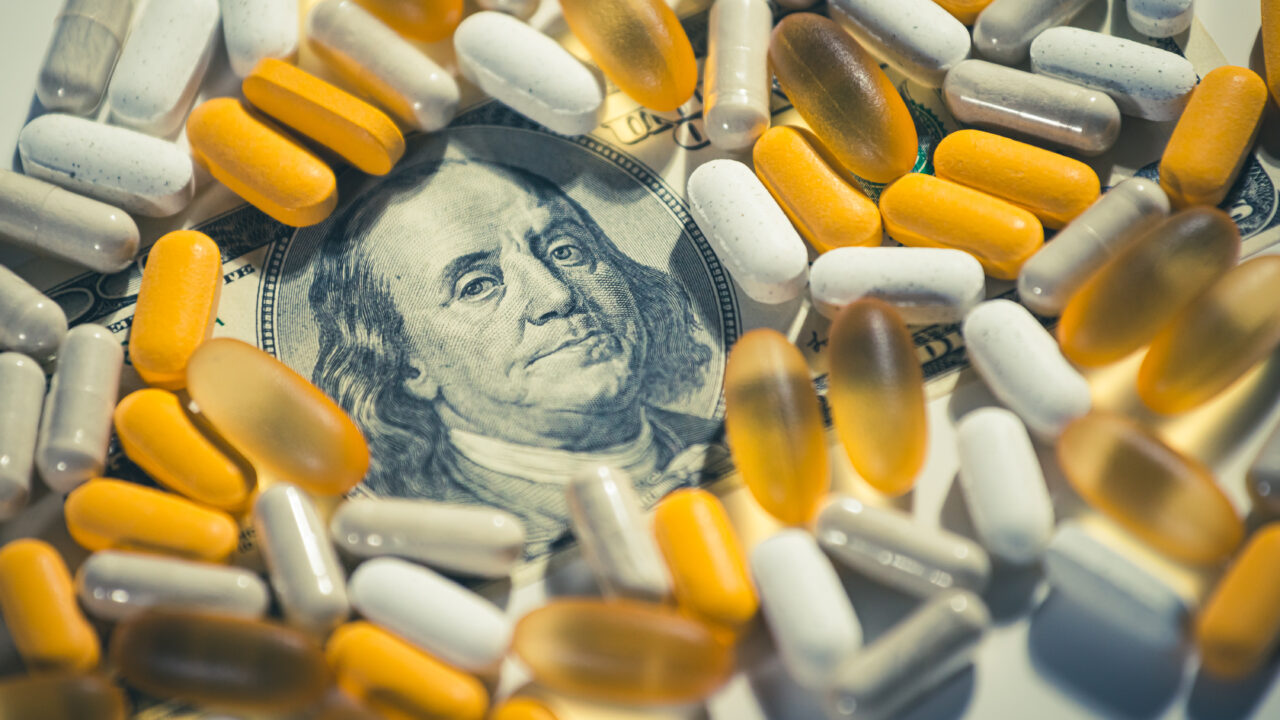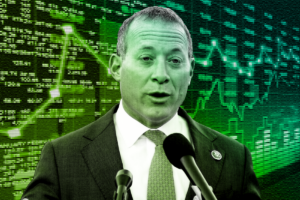Wall Street Opposes Lowering Drug Prices, Prefers Exorbitant Profits
The government is trying to make good on its promise to regulate overpriced prescription drugs, but private equity doesn't want to lose its extremely lucrative income stream. Image: Adobe
Image: Adobe
The following article was first reported and published by The Lever, a reader-supported investigative news outlet that holds the powerful accountable.
As the Biden administration launches a long-awaited fight to lower prices of life-saving drugs developed with public funding, a formidable industry opponent of the effort has emerged: venture capital firms.
The firms’ adamant pushback highlights how dependent Wall Street has become on wildly high drug prices, which thanks to scant regulation and exclusive patents mean big returns on investment for venture capitalists, and increasingly unaffordable medicine for patients.
In March 2023, the White House announced plans to review and potentially invoke its long-standing authority — dubbed “march-in rights” — to seize the patents of publicly funded drugs and allow generic competition in order to address egregious cases of drug pricing. The Bayh-Dole Act of 1980 allows such government intervention, but the authority, despite years of petitions, has never before been used.
In early December, the National Institute of Standards and Technology, a branch of the U.S. Department of Commerce, released a draft framework for the White House’s new march-in strategy for public comment. The proposal, which specifically addressed high drug prices, further stoked Wall Street’s fears that the government might soon come for its drug profits. And since then, the White House has faced a wall of opposition to the proposal, not just from Big Pharma, but also from the venture capitalists making billions off life-saving medicines.
The firms’ adamant pushback highlights how dependent Wall Street has become on wildly high drug prices.
On Jan. 23, the National Venture Capital Association (NVCA), which represents hundreds of venture capital firms around the country and spends millions lobbying lawmakers each year, quietly sent a letter to President Joe Biden expressing its “absolute opposition” to the proposal.
“Venture capital (VC) funding is essential to maintaining innovation — America’s lifeblood,” Bobby Franklin, NVCA’s president, wrote in the letter. “We urge you to immediately withdraw the [proposal] and abandon your administration’s broader march-in strategy.”
The letter is emblematic of Wall Street’s tooth-and-nail strategy to beat back the looming reforms. Dozens of venture capital firms, angel investors, and organizations that represent them have flocked to declare their opposition to the White House’s plans to slash drug prices, according to The Lever’s review of the hundreds of public comments on the new march-in plan.
“There are a lot of people making money on the Bayh-Dole Act,” said James Love, director of Knowledge Ecology International, a nonprofit that staunchly supports the use of march-in rights to bring down drug prices. “And right now, we’re trying to kill the goose that lays the golden egg.”
“We don’t have anything additional to add at this time, as the letter to the White House and comments to [National Institute of Standards and Technology] outline all our arguments,” wrote Robin Ceppos, a spokesperson for NVCA, in response to questions from The Lever.
“Everybody Was Looking For A Return On Their Investment”
In 1980, the Bayh-Dole Act allowed institutions like universities to take ownership of patents for inventions that were developed with public funding and then license them to private businesses. In effect, the law allowed the commercialization of government-funded inventions. Many pharmaceuticals originated this way, including the drug Xtandi, a life-saving medicine that treats advanced prostate cancer.
The case of Xtandi is a near-perfect case for the use of march-in rights, in the eyes of advocates like Love. The drug’s development by researchers at the University of California Los Angeles (UCLA) was funded by grants from the National Institutes of Health and the U.S. Army. In 2005, UCLA licensed the patents behind Xtandi to Medivation, a venture capital-backed pharmaceutical company that was later acquired in a $14 billion deal by major pharmaceutical manufacturer Pfizer.
Xtandi — now marketed jointly by Pfizer and the Japanese pharmaceutical giant Astellas — is sold at an egregious premium in the U.S., at an average market rate of $189,900 per year. While Xtandi is still costly in other countries, none come close to the U.S. price. In Japan, Xtandi is sold for less than $25,000 a year.
“You can easily see why this is priced as it is. Because everybody was looking for a return on their investment,” said Robert Sachs, a Boston-based attorney who was prescribed Xtandi in 2020 and then petitioned the Department of Defense, which funded the drug’s development, to invoke its right to seize the Xtandi patents and allow for cheaper generic competition.
Xtandi — now marketed jointly by Pfizer and the Japanese pharmaceutical giant Astellas — is sold at an egregious premium in the U.S., at an average market rate of $189,900 per year.
The Bayh-Dole Act allows for the federal government to seize patents if it deems inventions that were developed with public funding — including drugs like Xtandi — are not being made available to the public on reasonable terms. As Sachs argued in his April 2021 petition to the Department of Defense, an annual drug cost of $189,900 seems to be clearly unreasonable.
In March 2023, the federal government under Biden rejected Sach’s petition to use march-in rights for Xtandi, as it had repeatedly before.
But on the same day, the government announced plans to review its march-in authority, and the National Institute of Standards and Technology’s resulting draft framework for march-in rights may change matters. If, that is, the government can manage to overcome pressure from Wall Street and Big Pharma, which are pouring resources into lobbying against the new march-in plan.
“It remains to be seen what happens here,” Sachs said of the march-in rights framework. “But I recognize that it’s uphill. Given the powerful interests like pharma, like bio[tech], like the venture capital lobby.”
“They Get To Write Out As Many Zeroes As They Want”
As Sachs emphasized, pharmaceutical companies like Pfizer aren’t the only companies making money off of publicly funded drugs. So are venture capital firms, who are often wildcat investors in promising medicines at early stages of development. Venture capitalists back biotech startups in the hopes that their drugs’ success will lead to an acquisition by a larger pharmaceutical company, delivering a good return.
This model, critics charge, has caused drug prices to skyrocket, as venture capitalists seek ever-increasing returns on investment, and pharmaceutical companies are given free reign to set prices as high as they would like before their monopoly patents expire.
In NVCA’s letter to the White House, the lobbying organization adopted a common argument of Big Pharma, Wall Street, and universities making money from drug research: Without the promise of a monopoly patent and big profits at the end of the line, angel investors will be less likely to fund early-stage drug research, thus hindering innovation.
“Simply put,” the group wrote, “the draft framework sends a signal to VCs to divert funding away from any companies leveraging federal funding because we can no longer trust both patents for already commercialized inventions and future inventions.”
The NVCA is venture capital’s primary trade association. The organization spent $2.3 million lobbying in Washington in 2023, including on “drug pricing issues” as well as on the NIST’s new framework. The group was joined in its opposition to the new march-in framework by dozens of venture capitalists and organizations that have venture capital firms as members, including an anonymous coalition of “private equity and venture capital investors” that has opposed the rule.
Other venture capital firms — such as Baltimore-based PTX Capital — have echoed the “venture-capital lifeblood” argument in their own criticism of the new framework. “The proposed framework would stem the tide of research and development in this country, creating disincentives for investment and entrepreneurship,” a partner at the firm wrote in a public comment.
“It’s just a question of, is it the case that no one’s counting? That they get to write out as many zeros as they want and no one asks any questions?”
But researchers have argued that, in fact, venture capital’s priorities in funding drug innovation are often misaligned with actual health needs. And Love emphasized that arguments like the NVCA’s were a red herring designed to distract from Wall Street’s focus on its own profits.
The firms “want the federal government to pay for the riskiest part, hand over the IP, and then they want to be able to go out and financialize the assets in whatever way they can — make as much money as they can,” he said. “And they want the narrative to be that they’re the good guys.”
“It’s not like you don’t want to give them any money,” Love continued. “It’s just a question of, is it the case that no one’s counting? That they get to write out as many zeros as they want and no one asks any questions? That’s the situation that we have.”
Industry groups have, at the same time, argued that Biden’s new framework would do little to actually reduce drug prices: “It is unlikely that the price of therapeutics will be reduced by the guidance in the next decade,” another venture capital firm wrote in the comments to the National Institute of Standards and Technology.
Such apparently contradictory messaging is difficult to reconcile, Love said. “On the one hand, they say the Bayh-Dole act will do nothing to lower prices,” he said. “And on the other hand, they say it’s going to completely destroy the industry. How can that be?”
Despite the histrionics from Wall Street, Love and his organization think the White House’s framework can still be strengthened. The new guidance, for instance, proposed intervening and forcing a generic competitor “if it appears that the price [of a product] is extreme, unjustified, and exploitative of a health or safety need.”
In its comments to the National Institute of Standards and Technology, Knowledge Ecology International wrote that this was the wrong standard, given that the Bayh-Dole Act says that inventions developed with public funding be made available on “reasonable” terms. “How do we get from reasonable to not extreme, unjustified, and exploitative?” the organization wrote.
The public comment period on the new guidance closed on Feb. 6, and the framework is expected to be finalized in the coming months. Even if the government does move forward with its plans to use march-in authority to lower drug prices, Sachs said it will likely move too slowly to revisit the Xtandi case before the drug’s patents expire in 2027 — “even if this is on the fast track, which it doesn’t appear to be.”
After that point, after 15 years on the market, other competitors will finally be able to manufacture the cheaper versions of the drug without the government’s intervention.
But Sachs believes that the pressure generated by his 2021 petition for the government to seize the Xtandi patents clearly played a role in the Biden’s administration’s new march-in strategy. “I’m going to devote my energies to trying to improve the draft guidance, however I can,” Sachs said.
Your support matters…Independent journalism is under threat and overshadowed by heavily funded mainstream media.
You can help level the playing field. Become a member.
Your tax-deductible contribution keeps us digging beneath the headlines to give you thought-provoking, investigative reporting and analysis that unearths what's really happening- without compromise.
Give today to support our courageous, independent journalists.






You need to be a supporter to comment.
There are currently no responses to this article.
Be the first to respond.